Ruaha National Park
National park in Tanzania From Wikipedia, the free encyclopedia
Ruaha National Park is a national park in Tanzania. In 2008, the Usangu Game Reserve and other important wetlands were added to the park, increasing its size to about 20,226 km2 (7,809 sq mi).
| Ruaha National Park | |
|---|---|
 | |
| Location | Tanzania |
| Nearest city | Iringa |
| Coordinates | 7°30′S 35°00′E |
| Area | 20,226 km2 (7,809 sq mi) |
| Established | 1964 |
| Visitors | 21,267 (in 2012[1]) |
| Governing body | Tanzania National Parks Authority |
The park is about 130 kilometres (81 mi) west of Iringa. The park is a part of the 45,000 square kilometres (17,000 sq mi) Rungwa-Kizigo-Muhesi ecosystem,[2] which includes the Rungwa Game Reserve, the Kizigo and Muhesi Game Reserves, and the Mbomipa Wildlife Management Area.[3]
The park's name is derived from the Great Ruaha River, which flows along its southeastern margin and is the focus of game-viewing. The park can be reached by car on a dirt road from Iringa, and there are two Airstrips – Msembe Airstrip at Msembe (park headquarters) and Jongomeru Airstrip, near the Jongomeru Ranger Post.[2]
Climate
During the dry season from May to October, the park experiences hot and dry weather with little to no rainfall. Temperatures can reach 35 °C (95 °F) during the day. Night temperatures drop to around 20 °C (68 °F). The vegetation in the park becomes dry, and rivers and water sources dwindle.[citation needed]
History and wildlife

Germany gazetted the Saba Game Reserve in 1910. British colonial authorities changed the name to the Rungwa Game Reserve in 1946.[2] In 1964, the southern portion of the reserve was excised and elevated to full park status.[2]
More than 571 species of birds have been identified in the park. Among the resident species are hornbills.[2] Many migratory birds visit the park.[2]
Other noted animals in this park are East African cheetah,[4] East African lion, African leopard, wild dog, spotted hyena, giraffe, hippopotamus, African buffalo, and sable antelope.[2][5]
Since 2005, the protected area has been considered a Lion Conservation Unit.[6]
Issues
- The park was formerly known for its large elephant population.[2] It had numbered 34,000 in the Ruaha-Rungwa ecosystem in 2009[7] before declining to only 15,836, plus or minus 4,759, in 2015.[8]
- In February 2018, the carcasses of 6 lions and 74 vultures were found. They appear to have been poisoned.[9][10]
References
External links
Wikiwand - on
Seamless Wikipedia browsing. On steroids.

